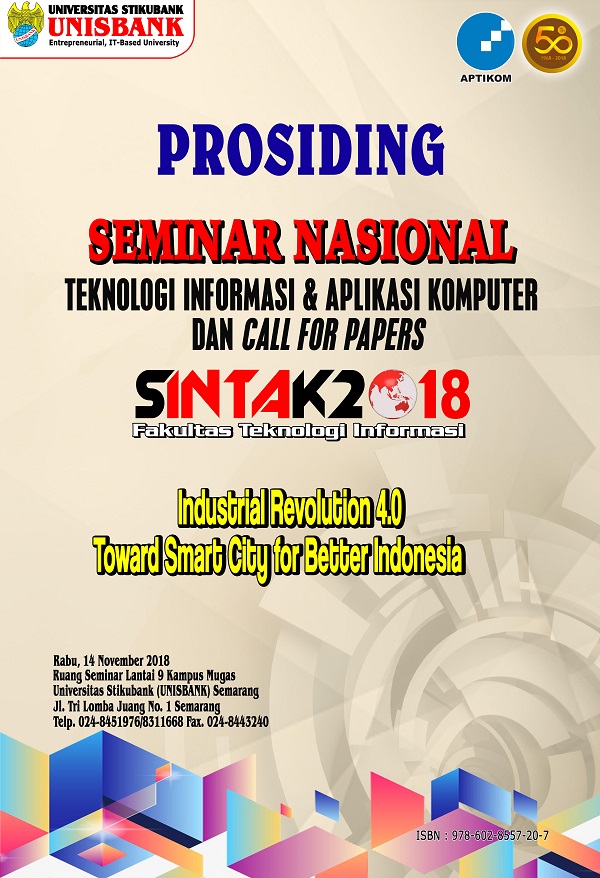PENGGUNAAN FIS MAMDANI DALAM MENENTUKAN DIMENSI KEPERCAYAAN WARGA DALAM PERSPEKTIF KETERBUKAAN INFORMASI PUBLIK
Abstract
Hak masyarakat untuk mendapatkan informasi dari Pemerintah menjadi sebuah kenyataan. Keterbukaan Pemerintah ini dikenal dengan istilah Open Government yang kemudian disingkat dengan OGI bersifat transparansi, partisipasi publik dan inovasi. Faktor kepercayaan masyarakat adalah hal utama yang mendapatkan perhatian sebagai wujud partisipasi warga. Kepercayaan dibangun berdasarkan tiga dimensi utama yaitu kemampuan (ability), kebaikan hati (benevolence) serta integritas (integrity). Tiga hal tersebut menjadi dasar penting untuk membangun kepercayaan seseorang agar dapat mempercayai suatu media, transaksi maupun komitmen. Sehingga berkaitan dengan keterbukaan informasi publik di Indonesia yang relatif masih baru tersebut, maka fenomena yang menarik untuk diteliti adalah sejauhmana kepercayaan (trust) partisipasi masyarakat dalam berkomunikasi dengan Pemerintah Daerah. Metode penelitian yang digunakan adalah dengan menggunakan metode FIS MAMDANI dan menggunakan MATHLAB sebagai toolsnya.
References
Allwinkle, Sam, and Peter Cruickshank. 2011. “Creating Smart-Er Cities : An Overview Creating Smart-Er Cities : An Overview.” Journal of Urban Technology, no. January 2014: 37–41. doi:10.1080/10630732.2011.601103.
Asadi, Mojtaba. 2016. “Journal of Rock Mechanics and Geotechnical Engineering Optimized Mamdani Fuzzy Models for Predicting the Strength of Intact Rocks and Anisotropic Rock Masses.” Journal of Rock Mechanics and Geotechnical Engineering 8 (2). Elsevier Ltd: 218–24. doi:10.1016/j.jrmge.2015.11.005.
Camastra, Francesco, Angelo Ciaramella, Valeria Giovannelli, Matteo Lener, Valentina Rastelli, Antonino Staiano, Giovanni Staiano, and Alfredo Starace. 2014. “Expert Systems with Applications A Fuzzy Decision System for Genetically Modified Plant Environmental Risk Assessment Using Mamdani Inference.” EXPERT SYSTEMS WITH APPLICATIONS, no. October. Elsevier Ltd. doi:10.1016/j.eswa.2014.09.041.
Caragliu, Andrea, Chiara Del Bo, Peter Nijkamp, Andrea Caragliu, Chiara Del Bo, and Peter Nijkamp. 2011. “Smart Cities in Europe.” Journal of Urban Technology, no. October 2012: 37–41. doi:10.1080/10630732.2011.601117.
Chen, Guanron, and Trung Tat Pham. 2001. Introduction to Fuzzy Sets, Fuzzy Logic, and Fuzzy Control Systems. Florida: CRC Press.
Espinosa, Jaito, and Joos Vandewalle. 2001. A New Paradigm of Knowledge Engineering by Soft Computing: Chapter 2 Linguistic Integrity: A Framework for Fuzzy Modeling — AFRELI Algorithm. Edited by Liya DIng. Vol. 5. Singapore: World Scientific Publishing Co, Pte. Ltd.
Gaeta, Angelo, Matteo Gaeta, Vincenzo Loia, and Marek Z Reformat. 2016. “Collective Awareness in Smart City with Fuzzy Cognitive Maps and Fuzzy Sets.” In FUZZ-IEEE, 1554–61. Vancouver, BC, Canada: IEEE. doi:10.1109/FUZZ-IEEE.2016.7737875.
Giffinger, Rudolf, Christian Fertner, Hans Kramar, Robert Kalasek, Nataša Pichler-Milanović, and Evert Meijers. 2007. “Smart Cities Ranking of European Medium-Sized Cities.” German: Centre of Regional Science, Vienna UT.
Guide, Matlab Team User. 2017. “What Is Mamdani-Type Fuzzy Inference_ - MATLAB & Simulink.” Accessed October 2. What Is Mamdani-Type Fuzzy Inference_ - MATLAB & Simulink.html.
Hall, Robert E, J Braverman, J Taylor, and H Todosow. 2000. “The Vision of A Smart City.” Paris, Perancis: 2nd International Life Extention Technology Workshop; Paris France. https://digital.library.unt.edu/ark:/67531/metadc717101/m2/1/high_res_d/773961.pdf.
Hesse-Biber, Sharlene Nagy. 2010. Mixed Methods Research: Merging Theory with Practice. The Guildford Press.
John, Andrew, Zaili Yang, Ramin Riahi, and Jin Wang. 2014. “Application of a Collaborative Modelling and Strategic Fuzzy Decision Support System for Selecting Appropriate Resilience Strategies for Seaport Operations.” Journal of Traffic and Transportation Engineering 1 (3). Elsevier: 159–79. doi:10.1016/S2095-7564(15)30101-X.
John W. Creswell. 2014. Research Design Qualitative, QUantitative, and Mixed Methods Approaches. United States of America: Sage Publications, Inc.
Joss, Simon, Matthew Cook, and Youri Dayot. 2017. “Smart Cities : Towards a New Citizenship Regime ? A Discourse Analysis of the British Smart City Standard Smart Cities : Towards a New Citizenship Regime ? A Discourse Analysis of the British Smart City Standard.” Journal of Urban Technology 0 (0). Taylor & Francis: 1–21. doi:10.1080/10630732.2017.1336027.
Kaltenrieder, Patrick, Ch- Bern, Edy Portmann, Matthias Finger, and Sara D Onofrio. 2014. “Applying the Fuzzy Analytical Hierarchy Process in Cognitive Cities.” In ICEGOV’14 Proceedings of the 8th International Conference on Theory and Practice of Electronic Governance, 259–62. Guimaraes, Portugal: ACM DIGITAL LIBRARY, New York. doi:10.1145/2691195.2691227.
Kaur, Arshdeep, and Amrit Kaur. 2012. “Comparison of Mamdani-Type and Sugeno-Type Fuzzy Inference Systems for Air Conditioning System,” no. 2: 323–25.
Komninos, Nicos, Charalampos Bratsas, Christina Kakderi, and Panagiotis Tsarchopoulos. 2015. “Smart City Ontologies: Improving the Effectiveness of Smart City Applications.” Journal of Smart Cities 1 (1): 31–46. doi:10.18063/JSC.2015.01.001.
Kusumadewi, Sri, and Hari Purnomo. 2004. Aplikasi Logika Fuzzy Untuk Pendukung Keputusan. 1sted. Yogyakarta: Graha Ilmu.
Maio, M L De. 2013. “Fuzzy Utility Models : Possible Applications in Evacuation Conditions in Smart Cities.” WIT Transactions on Ecology and The Environment 173: 779–90. doi:10.2495/SDP130651.
Melo, Fabrício Silva, José Lucas, and Matos Silva. 2016. “Flood Monitoring in Smart Cities Based on Fuzzy Logic about Urban Open Data,” 2–6.
Mosannenzadeh, Farnaz, and Daniele Vettorato. 2014. “Defining Smart City: A Conceptual Framework Based On Keyword Analysis.” Edited by Rocco Papa. TeMA Journal of Land Use, Mobility and Environment, no. SMART CITY PLANNING FOR ENERGY, TRANSPORTATION AND SUSTAINABILITY OF THE URBAN SYSTEM. Naples: Laboratory of Land Use Mobility and Environment DICEA Univiresity of Naples “Federoco II”: 683–94. doi:10.1007/s11277-009-9693-4.
Nam, Taewoo, and Theresa A Pardo. 2011. “Conceptualizing Smart City with Dimensions of Technology , People , and Institutions.” In The Proceedings of the 12th Annual International Conference on Digital Government Research, 282–91. https://www.ctg.albany.edu/publications/journals/dgo_2011_smartcity/dgo_2011_smartcity.pdf.
Retnowati. 2010. “Optimalisasi Jumlah Produksi Batik Cap Dengan Menggunakan Metode Fuzzy Mamdani.” Jurnal Litbang Kota Pekalongan 3 (1): 1–11.
———. 2017. “Partisipasi Warga Melalui Pusat Informasi Warga ( Community Dalam Perspektif Keterbukaan Informasi Publik Di Era OGI ( Open Government Indonesia ) Studi Pada Kota Pekalongan.” https://www.academia.edu/34688226/Partisipasi_Warga_Melalui_Pusat_Informasi. https://www.academia.edu/34688226/Partisipasi_Warga_Melalui_Pusat_Informasi.
Schensul, Stephen L., Jean J. Schensul, and Margaret D. LeCompte. 2013. Initiating Ethnographic Research: A Mixed Methods Approach. UK: Rowman & LittleField Publishers, INC.
Shah, Jagan. 2017. Exploratory Research on Smart Cities: Theory, Policy and Practice. India. https://cidco-smartcity.niua.org/exploratory-research-on-smart-cities/.
Shokouhi, M Ajza, S N Naghibi Rokni, H Alizadeh, and A Ahmadi. 2016. “Evaluation of Smart City Criteria in Ahvaz City , Iran PhD Student in Geography and Urban Planning , Shahid Chamran University of Ahvaz , Iran 4PhD Student in.” International Journal of Architect, Engineering, Urban Plan 26 (2): 141–49. doi:10.22068/ijaup.26.2.141.
Yoshihito Yoshikawa, Atsutoshi Sato, Shigeki Hirasawa, Masato Takahashi, and Mayuko Yamamoto. 2012. “Hitachi’s Vision of the Smart City.” Hitachi Review. Japan.
Zadeh, Lofti A. 1988. “Fuzzy Logic.”

